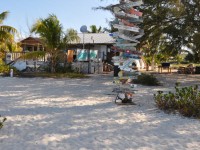With the 5800 nautical miles we logged over the past 8 and a half months, Altera now has now covered approximately 13000 nautical miles. While this isn’t a lot for a cruising boat, we want to keep her in top shape so that we can avoid any notable equipment issues during our travels. Here is an overview of the maintenance we have planned this summer to keep Altera in top shape:
Sails:
We are very happy with the durability of our sails from Bay Sails in Hamilton and after a close inspection only have a few minor items to take care of which include:
Replace the leach line in the mainsail where it chafed through to the core at the 3rd reef cleat.
Small patch on the 130% genoa where presumably the spreader or radar wore a small hole in the sail during a tack or jibe.
Add chafe protection on the foot of the working Jib where it rubs on the lifelines when close reaching.
Consider adding chafe protection to the mainsail where it sometimes contacts the spreaders when sailing downwind in gusty conditions.
Engine (in addition the the regular oil, filter and raw water impeller changes):
Clean the dog fur out of all the nooks and crannies and clean with a degreaser. The cleaner the engine the easier it is to find a potential problem when it arises.
Check the valve clearances as the engine now has ~2000 hours on it.
Rebuild the original raw water pump so that we again have a spare.

Rig:
Chrissy hauled me up the mast before we departed the Bahamas to do a complete inspection, and as you can never inspect it too often one of us will go up again.
Inspect the chainplates. For this I need to remove a panel behind our bookshelves (fortunately it looks like it was designed to allow for inspections). For the non sailors, the chainplates are the big stainless brackets that transfer the load from the wires holding the mast up to the structural parts of the hull.
Running Rigging:
Replace the mainsheet. It is starting to show its age. Although it likely isn’t a real concern, I already have a suitable line to use, so it is just my time to execute this one.
Replace or at least acquire a spare for the first and second reef lines.
Clean and lubricate winches.
Service and lubricate the furler and upper swivel.
Hull:
We have worn through the antifouling paint in a few places and have been starting to see more and more of the base layer as the miles add up. We are thinking of switching from Micron CSC to Micron 66 as it is supposed to be more effective in warm waters, and the CSC that we were using really started to lose effectiveness by the middle of winter. Micron 66 isn’t available in Canada so we may wait until the fall to haul the boat for painting.

Polish and Wax and the hull above the water line. The boot stripe needs a good cleaning with a cleaner wax and I plan to continue waxing the hull every 3-4 months to protect it from UV. I already waxed the topsides, cockpit and transom before we flew back to Ontario.
Deck:
Our teak decks are holding up well, but I have about 3 linear feet of caulking to touch up. I also have one missing plug on the port side deck that has revealed one of the screws and several on the swimstep that need to be dealt with. Other than that, we just need to clean the decks with Boracol to get rid of some mildew in the few spots that trap water after a rainfall or sailing.
Plumbing:
Change the joker valve. For you non-boaters don’t ask…. It’s the check valve (back flow prevention) for the toilet. The name is quite apt as they don’t work well and are not pleasant to change.
Check and descale the hoses for the head if necessary. I miss the fresh water lakes. No salt to crystalize with urine making already small hoses effectively much smaller with every flush.
Replace the galley faucet. Mid-winter we started to hear the occasional drip, the frequency of which has been increasing. Given that water is precious on a boat this needs to be rectified.
Improve the water heater insulation. It has cracked and separated from the tank in a few places and now that we are in the cold climate we will likely want to have hot water for showers.
Varnish:
The counter edge around the galley sink is due for a light sand and a couple of coats of varnish and the trim around the companionway will get the sam.
The handholds on deck also need a few coats.
I think that wraps up the bulk of the maintenance items. For the experienced boaters that may be reading this, if I’ve missed anything that I should be tending to let me know. And for those that think they want a boat, be warned that many of these tasks are annual tasks. Oh that labour of love.




Try Oxybrite on your deck.Wayne used it on starboard stuff and now is white white.Friends of ours at MBSC used Oxybrite on there deck and people think they’re getting ready to sell.! Their top deck has never been so white. Our granddaughter helped clean white reception tents with it too. Good for sails??
Thanks for the tip. I might give it a try on the dinghy and will keep it in mind for any plastics. We are a bit particular about what we use on the teak decks, so for that we will stick to something milder.
Forgot you had teak decks.You’re right–best not to use Oxybrite on them.
Forgot you had teak decks.You’re right–best not to use Oxybrite on them.
Hi, Chrissy and Jeff… The maintenance never stops and is as important as you say. My personal lack of skill and confidence is a major contributor to never leaving for a trip like yours, 20 years ago, when we were proud owners of a Tayana 37. When confident about your ability to execute the necessary task it can, almost, become enjoyable… Have a good time!
Walter